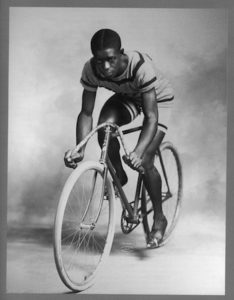
Marshall Taylor
This date marks the birth in 1878 of "Major" Taylor. He was a Black cyclist and one of the preeminent American sports pioneers of the 20th century.
Marshall Walter Taylor was born on the outskirts of Indianapolis. He was one of eight children raised in rural poverty near the noise and bustle of a rapidly expanding industrial city. At 13, with the bicycle given to him by a friend, Marshall began to earn his first few dollars delivering newspapers. Taylor then worked in a bicycle shop repairing, teaching customers how to ride bicycles, and doing exhibitions and tricks after regular working hours.
He first appeared as an amateur in races around Indianapolis and Chicago and later in Massachusetts, Connecticut, and New York. Soon recognized as the "Colored Sprint Champion of America," he turned professional and astonished many. He continued to work at the bike shop until prominent bicycle racer "Birdie" Munger coached him to his first professional racing success in 1896.
Despite continuous bureaucracy and physical opposition, he won his first national championship two years later, became world champion in Montreal in 1899, and American sprint champion in 1899 and 1900.
He broke a series of world records and, in 1901, received acclaim during a triumphant tour of Europe, the most international tour of European countries ever undertaken by an African American athlete. He enjoyed a position of unequaled supremacy against the best bicycle racers in the world. Taylor was the world's fastest bicycle racer for 12 years.
Between 1890 and 1910, bicycle track racing was as popular as today's major sports. During the Jim Crow era, when Black people were expected to know their place and not to challenge the dominance of whites, the success of this determined young man came as a disturbing shock, and his astounding athletic speed was a revelation.
He was almost certainly the first Black athlete to have a commercial sponsor and the first to establish world records. He also represented Black America abroad when many European people had never seen a Black person. In a world without cars, motorcycles, or airplanes, racing cyclists were the fastest humans on earth. They were heroic and glamorous figures. When Marshall Taylor died penniless in 1932 in Chicago at the height of the Depression, he was buried in a pauper's grave. He was reburied in 1948, and his achievements were praised at a Chicago memorial ceremony.
Contemporary Black Biography, various volumes
Edited by Shirelle Phelps
Copyright 1999 by Gale Research, Detroit, London
ISBN 0-7876-1275-8